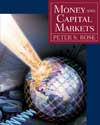 |  Money and Capital Markets: Financial Institutions and Instruments in a Global Marketplace, 8/e Peter Rose,
Texas A & M University
The Tools and Goals of Central Bank Monetary Policy
Chapter SummaryThe policy tools used by central banks, such as the Federal Reserve System, impact the
quantity and rate of growth of legal reserves in the banking system and, in turn, the cost and
availability of credit.
- The principal immediate target of Federal Reserve policy today is the federal funds interest
rate, which, in turn, affects interest rates in both the money market and the capital
market and, ultimately, the strength of the economy as a whole.
- The main policy tool used by the Federal Reserve to influence the cost and availability
of credit is open market operations—the buying and selling of securities through the
Trading Desk of the Federal Reserve Bank of New York. Open-market sales tend to
raise interest rates and restrict the supply of credit available, while open-market purchases
tend to lower interest rates and expand the supply of credit.
- The Fed, like many other central banks around the globe, has other broad policy tools at
its disposal in the form of deposit reserve requirements and the discount rates of the individual
Federal Reserve banks. An increase in reserve requirements or in the discount
rate tends to tighten money and credit policy, slowing borrowing and spending, while a
reduction in reserve requirements and Federal Reserve bank discount rates tends to ease
monetary policy, leading to an expansion of money and credit at lower cost.
- While open market operations, reserve requirements, and discount rates represent general
credit controls, most central banks also have selective credit controls that impact
specific groups or sectors of the financial system and the economy. The Federal Reserve’s
selective controls include moral suasion (or psychological pressure applied by
central bank officials) and margin requirements (which restrict purchases of selected securities
on credit).
- As open market operations have become the central tool of the Federal Reserve and
other central banks around the globe, different varieties of this important central bank
tool have been developed. Examples include straight or outright open market operations
(where actual title to security ownership changes hands), repurchase agreements (where
only temporary transfer of security ownership occurs), run-off transactions (where the
central bank demands cash for maturing securities), and agency transactions (where the
central bank acts to buy or sell securities on behalf of a central bank customer, such as
a foreign government or foreign central bank).
- Besides central bank monetary policy other important groups acting in the economy and
financial system also affect interest rates and the reserves of the banking system, including
actions of the public (such as demanding additional supplies of currency and
coin) and operations of the government’s treasury (as when the government sells or redeems
securities or collects taxes). The central bank must often act defensively to counteract
these other sources of change in the financial marketplace, using its policy tools
as a counterweight to actions taken by the public and the government.
- When the Federal Reserve decides to change the desired level of the federal funds interest
rate it uses open market operations to change the quantity of nonborrowed reserves
held by depository institutions. Nonborrowed reserves plus borrowed reserves
(loaned to depository institutions by the Federal Reserve banks) make up the supply of
total reserves at the disposal of the banking system.
- The principal economic goals pursued by most central banks include the control of inflation,
achieving full employment, achieving sustainable economic growth, and attaining
a stable equilibrium in the nation’s balance of payments with other nations.
Unfortunately the policy goals often conflict, requiring the central bank to compromise,
sometimes achieving only a portion of one sought-after goal (such as combating inflation)
in order to avoid doing too much damage to another desired goal (such as achieving
full employment for all those willing to work).
|
|




 2003 McGraw-Hill Higher Education
2003 McGraw-Hill Higher Education